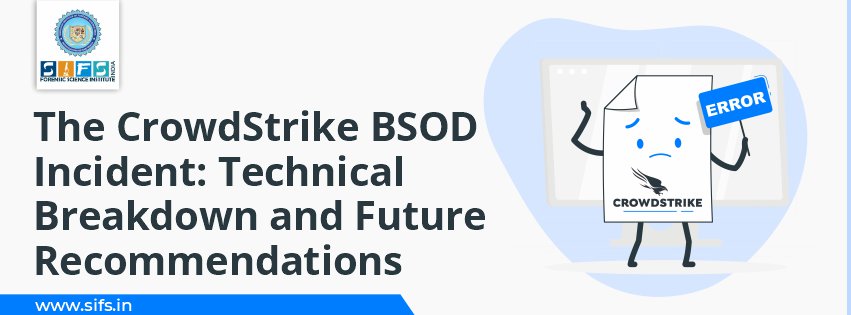- Call Us: +91 7303913002
- Email Us: education@sifs.in
The CrowdStrike BSOD Incident: Technical Breakdown and Future Recommendations

BY SIFS India | July 20, 2024
The CrowdStrike BSOD Incident: Technical Breakdown and Future Recommendations
On July 19, 2024, cybersecurity firm CrowdStrike experienced a significant technical mishap that led to widespread system crashes, famously known as the "blue screen of death" (BSOD), for many Windows users.
This blog post provides a comprehensive overview of what transpired, the technical underpinnings of the issue, and recommendations to prevent similar events in the future.
Details of the Incident
On the aforementioned date, CrowdStrike rolled out a configuration update for its Falcon sensor software, affecting Windows systems running versions 7.15 and 7.16.
The update, meant to improve security, unfortunately caused severe system instability, leading to the dreaded BSOD.
Despite the chaos, CrowdStrike quickly clarified that this was not a security breach but rather an unintended consequence of a routine software update.
In response to the crisis, CrowdStrike acted swiftly to deploy a corrective solution.
Users were instructed to use a temporary workaround: booting Windows in safe mode or the Windows Recovery Environment and deleting a specific file to restore system functionality.
This incident underscored the risks associated with relying solely on one cybersecurity vendor and emphasized the importance of a diversified cybersecurity infrastructure.
How It Went Wrong: A Technical Perspective
The issue stemmed from a malfunction in the sensor's update process. Specifically, it affected channel files located in `C:\Windows\System32\drivers\CrowdStrike\`, with filenames beginning with "C-" followed by a unique identifier.
The problematic file, Channel File 291, is crucial for evaluating named pipe executions on Windows systems.
The update, deployed at 04:09 UTC, aimed to target and mitigate malicious named pipes used by command-and-control (C2) frameworks. However, it inadvertently triggered a logic error that led to an operating system crash.
What Reverse Engineering Reveals?
Reverse engineering analysis pinpointed the root cause of the system crashes to a null pointer dereference in the `csagent.sys` driver.
The recommended fix involves removing all drivers named `C-00000291*.sys`. This bug likely originated from these drivers and was processed by the `csagent` driver.
The kernel, a critical component of the operating system responsible for managing drivers, was adversely affected by this error.
Additionally, the presence of numerous null bytes in the file raised concerns about potential errors during the file's packaging, disk writing, or final adjustments.
Recommendations to Prevent Future Incidents
To mitigate the risk of similar incidents, organizations should adopt the following recommendations:
Enhance Testing Infrastructure: Incorporate automated testing tools and methodologies that align with production processes. Seamlessly integrating testing procedures into the development pipeline can help identify and address issues before they reach end-users.
Real-Time Code Monitoring: Implement robust monitoring solutions and performance analytics to detect anomalies or performance degradation in real-time. This proactive approach can provide valuable insights into how code behaves under real-world conditions.
Strong Governance Practices: Establish clear guidelines, protocols, and accountability frameworks to ensure transparency, compliance, and effective risk management. Align governance practices with industry standards and best practices.
Thorough Evaluation of Cloud Service Providers: Conduct comprehensive assessments of cloud service providers' security, compliance, and reliability measures. Consider their track record, certifications, and independent audits before making decisions.
Invest in Monitoring and Observability: Adopt advanced monitoring tools, anomaly detection systems, and proactive alerting mechanisms. Data-driven insights can help anticipate and mitigate potential issues before they escalate.
Efficient Rollback Procedures: Implement robust version control systems and automated rollback mechanisms. Ensure that rollback processes are well-documented and tested to minimize disruptions in the event of an issue.
Minimize Dynamic Updates: Implement a well-defined change management process and conduct thorough impact assessments before applying updates. Prioritize system stability by carefully managing changes.
Incident Response and Disaster Recovery: Develop comprehensive response plans, conduct regular drills, and establish clear communication protocols. Ensure that teams are well-prepared to handle unexpected incidents effectively.
Reliable Technology Stack Testing: Use reliable availability metrics, such as uptime and response time, to continuously monitor and optimize the performance of technology stacks. Ensure that they remain reliable and resilient.
Engage with Vendors Thoughtfully: Gather information from trusted sources and seek formal responses from vendors before proceeding with any actions. Thoroughly test vendor fixes in a controlled environment to ensure they do not introduce new issues or vulnerabilities.
Learn from Past Incidents: Conduct post-incident reviews to identify root causes and implement corrective actions. Create a culture of continuous improvement by applying lessons learned from previous incidents.
Final Words
By adhering to these recommendations, organizations can better safeguard their systems against similar disruptions and enhance their overall cybersecurity posture.

